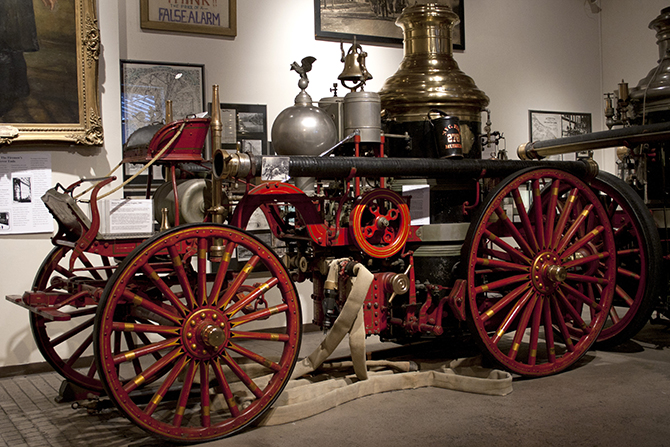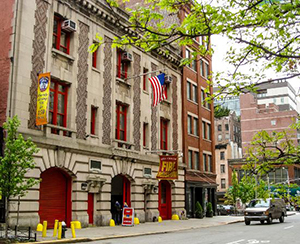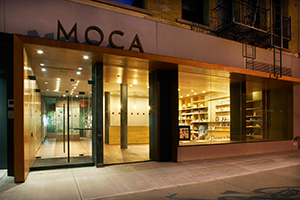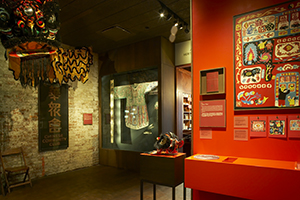NYC HAPPENINGS
Under-The-Radar Museums

By Clint Brownfield
New York City is the capital of the world chiefly due to its incredible diversity, and this is reflected in the city’s museums—there is something for everyone. It would take 4-to-5 years to visit all 220 museums if you went to one museum each week. By that time, there would be even more to explore. Here, we begin a series that will highlight some of the more off-the-beaten-path museums in our five boroughs that are worth seeking out.
NEW YORK CITY FIRE MUSEUM
This inviting crowd pleaser announces itself visually as you travel along Spring Street just west of SoHo. Fittingly, the New York City Fire Museum is housed in a beautifully preserved 1904 firehouse, former quarters of FDNY Engine Company No. 30. Just inside the front door guests are greeted by a friendly staffer. And, if you are a shopaholic, you will notice one of the most beguiling gift shops in the city.
 New York City Fire Museum
New York City Fire MuseumIt’s not fair to call this a small museum. Any museum in the city is smaller than such ‘big box’ institutions as The Met, MoMA, The Brooklyn Museum, and the American Museum of Natural History. Here, the main exhibition areas comprise several thousand square feet, spread out over two floors of the building. Displays illustrate the evolution of firefighting from the bucket brigades of Peter Stuyvesant’s New Amsterdam through the colorful history of volunteer fighters to modern firefighting techniques and equipment. The museum also houses a unique memorial to the 343 members of the FDNY who lost their lives on 9/11 and features many firefighting artifacts recovered from the World Trade Center site. A video room and a mock apartment with an artificial smoke machine and black-lighted fire hazards are great ways for kids to learn about fire safety at home.
Visitors can enjoy the museum via self-guided tours or take advantage of knowledgeable onsite volunteers—many of whom are retired firefighters. Standouts in the collection are some fancy vintage carriages that would be suitable for royalty to ride off into the sunset after being married. These exquisite vehicles were used mainly for parades and ceremonial occasions.
The museum’s third floor is an excellent venue for weddings, special events and birthday parties for young children.
For more information on the New York City Fire Museum, visit nycfiremuseum.org.
 Exterior of the Museum of Chinese in America
Exterior of the Museum of Chinese in AmericaMUSEUM OF CHINESE IN AMERICA
At this gem of a museum, visitors will be entering one of Maya Lin’s few projects in New York City. Lin, as you may know, also designed the Vietnam War Memorial in Washington, D.C. While still an undergraduate at Yale, at age 21, her design was chosen out of 1,421 entries in the public competition. The memorial, one of the most influential of the 20th century, was completed and dedicated one year later—in 1982.
Lin’s design for the Museum of Chinese in America (MOCA) is but one of the many reasons why you should seek out the museum. MOCA is located just a couple of blocks north of Canal Street on Centre Street.
Although most New Yorkers have enjoyed trips to Chinatown for its great food and shopping, there are still some unaware of the rich history of this area. Did you know it’s become the largest enclave of Chinese people in the Western Hemisphere with an immigration that began in the mid-1800s? MOCA, through its permanent collections and special exhibitions, shows and tells us how this happened over 160 years throughout North America.
Founded in 1980, MOCA moved from its former quarters in Chinatown’s PS 23 building on Mott Street to its present Maya Lin-designed location in 2009. The former structure is still used for special exhibitions and to store items not on view at the Centre Street location.
Today, when one enters MOCA, Lin’s design leaves no detail to chance. The wall behind the ticket and information counter very simply, and beautifully, let’s you know where you are. The wall to the left is made up of exquisite bronze rectangles resembling building blocks. Each of these are plaques with the names of prominent Chinese Americans, including one with the names of Maya Lin’s parents, who immigrated to the States in the late 1940s. All names are written in English and Chinese characters. Even the museum’s flooring is unique—made up of vertically inlaid hardwood pieces, so the tops resemble the surface of a traditional Chinese stone walkway. A remnant from the original building is retained on the lower level and is reminiscent of the courtyards typical to Chinese homes.
 Museum of Chinese in America
Museum of Chinese in AmericaAll this gives way to the exhibits inside the museum. One room flows into the other telling the stories of Chinese people in America and their incredible journeys. The museum has also amassed the most extensive collection of recorded oral histories in the world—perhaps the best way of all to preserve this rich history.
So, you’ve just completed your visit to MOCA and you’re undoubtedly hungry. Never fear: MOCA can also suggest an exciting food tour in Chinatown where you can sample the best pork buns, soup dumplings and sponge cakes you may ever enjoy.
For more information on the Museum of Chinese in America, visit mocanyc.org.












